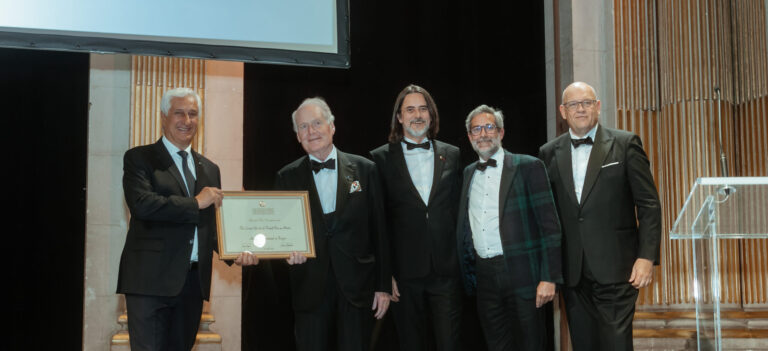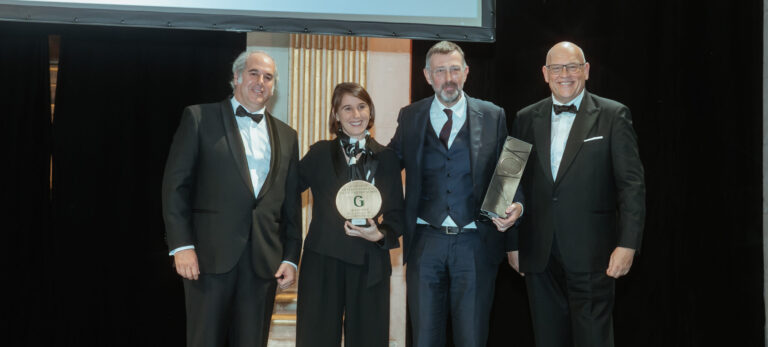Austria
Austrian Academy of Gastronomy
The Austrian Academy of Gastronomy was founded on September 17, 1992 in Salzburg. Its founders were Duke Ratibor, Prof. Mautner-Markhof, Mons. Leo Wallner, Dr. Wolfgang Berger (in his “Reitgut” the foundation was made) and Count Walderdorff.
The Academy tries to organize two gastronomic and cultural trips per year and various gastronomic events in the Salzburg area, always looking for good restaurants. Countries visited include: Italy, France, Germany, Switzerland, Liechtenstein, Slovenia, and Slovakia.
- President: Johannes Walderdorff
- Vice President: Evelyn Beuerlein and Inge Pallauf
- Treasurer: Walter Rousek
- Secretariat: Inge Pallauf, Gneiserstraße 42, 5020 Salzburg, +43 662 820343-0 (fax: -4)
History of Austrian cuisine
Austria lies at the heart of Europe, at the crossroads of peoples and cultures in contact with each other and which crystallized to give birth to the country and the people forming present-day Austria,
Until the First World War, the Austro-Hungarian Monarchy occupied nearly 700,000 km², had 52 million inhabitants, 16 different languages, and an even greater number of different cuisines. All these peoples, countries, cultures, languages, and cuisines—Austrians, Magyars, Slavs, Poles, Ruthenians, Romanians, and Italians—were eventually represented in the metropolis of Vienna. In this context, Austrian cuisine, and especially Viennese cuisine, can be said to be the legacy of the Habsburg Monarchy. Each crown country made its own contribution. Pastries came from Bohemia, poultry, chili dishes, and strudels from Hungary, lamb dishes, spit-roasted dishes, and honey pastries from the Balkan countries. Dalmatia and Istria provided seafood. Galicia and Transylvania were the grain granaries.
These contributions from each people gave rise to new recipes, nuances, spices, combinations, and new ingredients. All of this was combined in the metropolis on the Danube, integrated into the court cuisine, and then made its way to the princely castles and finally to the bourgeois homes. All the fine dishes of the court were thus simplified, becoming more substantial and more authentic.
19th-century Austrian cuisine adapted the differences of a national dish and refined the coarse peasant dishes. The dishes received the Viennese touch of the upper middle class. Let us now compare them to French cuisine. In this cuisine, the most cultured and refined dishes are called “à la reine,” “à la princesse,” “à la duchesse.” In Viennese, home-cooked dishes and dishes of traditional cuisine bear the mention “imperial” (kaiserlich) or “emperor” (kaiser) in their name, whether they are Kaiserschöberl (savory cracker for emperor’s soup), Kaiserguglhupf (emperor’s bundt cake), Kaiserschmarr (emperor’s sweet omelet), Kaiserfleisch (emperor’s meat), or Kaisersemmeln (emperor’s rolls).
It is therefore not surprising that the name Viennese cuisine has spread throughout Austria. Indeed, a long tradition has it that the Austrian Länder (regions) still consider themselves independent of the duchies from which they originate. There was indeed already an independent “Tyrolean cuisine” before “Viennese cuisine.” However, it should be noted in this regard that Viennese cuisine is one of the few cuisines that has always borne the name of the city and that has spread throughout the country. Today, for example, we know Parisian or Roman cuisine, but no one thinks at the same time of the respective cuisine of the country. Austrian cuisine, on the other hand, has only achieved worldwide fame under the name “Viennese cuisine.”
One dish, the Viennese schnitzel—the subject of numerous stories—has achieved worldwide fame. In 15th-century Italy, it was fashionable in wealthy homes to garnish dishes with gold leaf. Doctors prescribed gold as a heart medicine. This luxury took over until it was eventually banned. Breading with egg and breadcrumbs and frying it until golden in very hot fat replaced this optical effect. This was also the case with “costoletta a la milanese.”
Radetzky, commander-in-chief of the Austrian army, who resided in Milan from 1850 to 1857 as Governor-General of the Habsburg Empire, took “costaletta a la milanese” as his favorite dish. When he returned to Vienna, his cook prepared a dish that was unmistakably similar to the one in Milan, but with significant differences in the recipe.
Instead of the veal chop, the juicy piece of the veal shoulder or the veal shoulder is used – that is, without bone. Roughly rectangular escalopes are cut and flattened to a thickness of about 4 mm. The chop, on the other hand, is always a little thicker. The meat is salted on both sides and turned over in wheat flour, but only covered with a very thin layer of flour. It is then dipped in a mixture of eggs mixed with water or milk. It is drained and turned over in crispy breadcrumbs – in the Milanese escalope, these are white breadcrumbs – which should not stick too much to the meat, and it is immediately placed in a large pan with heated pork fat to a depth of one inch. Each side is fried for about 1 1/2 minutes until golden yellow. The pan should be shaken regularly so that the breading can breathe. It should not stick to the meat. It is said that you should be able to pass a knife blade between the meat and the breading. After this cooking in the pan, you can turn the escalope a little more in hot melted butter or cook it immediately in concentrated butter.

Before serving, it is essential to drain the fat. It is also important not to stack the cutlets on top of each other or cover them. It is served with a little parsley and a slice of one-sixth of a lemon, which is squeezed over the cutlet. A green salad, potato salad, or cucumber salad is served with the cutlet.
Another dish that has not achieved the same international fame, however, is a must-have in Austria – boiled beef. A cultured Austrian should, it is said, be able to speak knowledgeably about at least a dozen cuts of beef. Nowhere else is beef cut into so many different pieces. It was Emperor Franz Joseph who made boiled beef so popular by making it his favorite dish. “Tafelspitz” (boiled beef rump) – the Emperor’s favorite part – is therefore found on every menu in Austria today.
In Vienna, one should definitely visit a restaurant specializing in beef to enjoy one or another cut of meat. This piece is accompanied by sautéed potatoes, chive sauce, and apple horseradish. Before serving this dish, the broth in which the piece of meat is simmering is poured into small cups. Often, a marrow bone is cooked with the whole dish. The marrow spread on a slice of toasted black bread can then be eaten by hand – seasoned with salt and pepper.
This broth, served with liver dumplings or semolina dumplings, is a favorite starter in Austria.
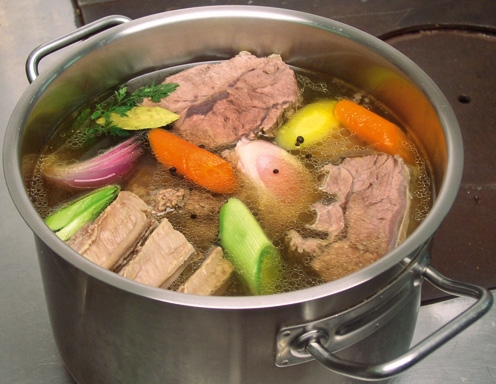
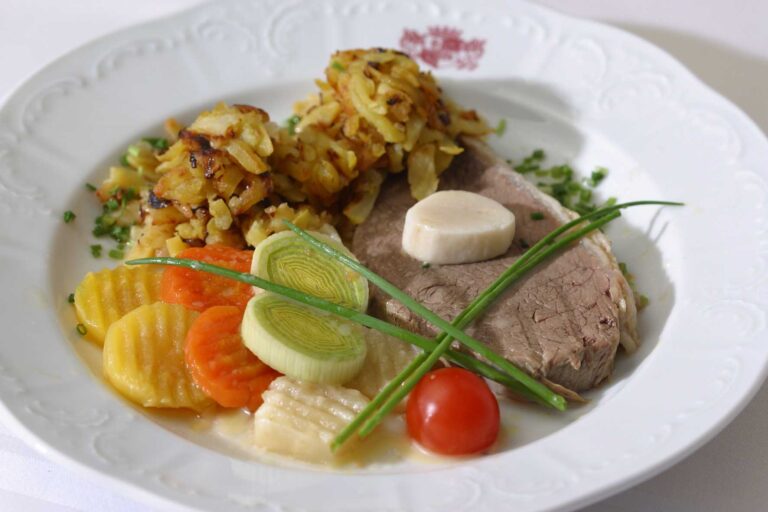
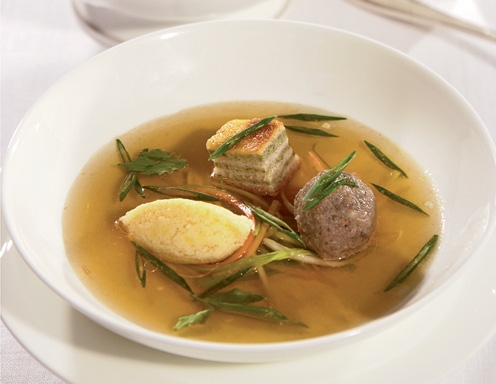
The “Sacher Torte” is undoubtedly the most famous Austrian pastry, alongside apple and cottage cheese strudels, “Salzburger Nockerl” (a type of vanilla soufflé), Linzertorte (Linz tart), Kaiserschmarrn (a type of large shortcrust pancake), apricot and plum dumplings, yeast dough doughnuts and Kouglof. In 1831, Franz Sacher began his apprenticeship as a cook in the household of Prince Metternich. One evening, a pie was ordered. Since no cook was available, the young apprentice set to work. His pie was highly praised and went on to conquer the world. The culinary dictionary “Appetit-Lexikon” gives the following explanation: “Sachertorte” refers to a sublime chocolate cake that is distinguished from other pastries of this type by the layer of apricot jam in the middle of the cake under the chocolate icing. After much discussion, it was agreed that the original “Sachertorte” from the Hotel Sacher is distinguished by a layer of jam under the top icing and another in the middle of the cake, while in the cake from Café Demel, this layer is only under the icing.
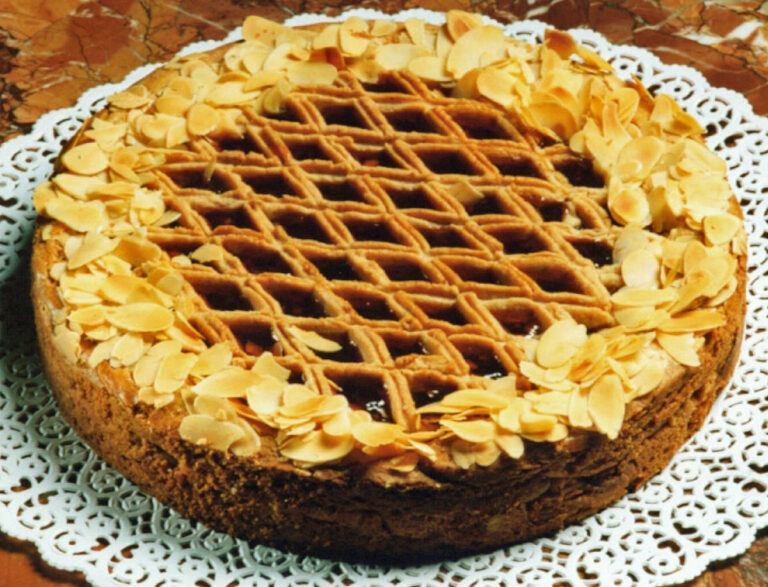
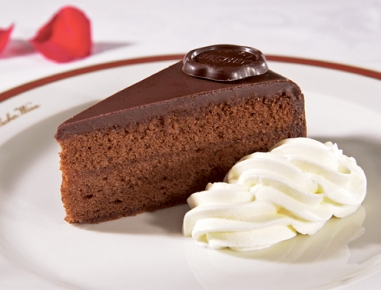
The “Linzertorte” also achieved worldwide fame with its grated almonds, red currant jam, and braided topping. It first appeared in 1619. The Viennese coffeehouse tradition also contributes to the fame of Austrian pastries. It is not without reason that the term “Viennese pastries” refers worldwide to small, delicate puff pastry products.
Austria’s 28 hotel schools enjoy an excellent reputation. The many foreign students have also helped to spread awareness of Austrian cuisine, and since 2008, you can even study gastrosophy at the University of Salzburg. Top Austrian chefs and hotel managers work all over the world, and according to a renowned ranking, the best German-speaking restaurant in the world is located in Vienna.
Austria can be proud of its cuisine and the country’s fine wines add to this reputation.

